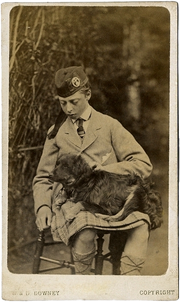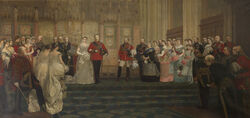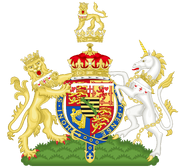Prince Leopold, Duke of Albany, KG, KT, GCSI, GCMG, GCStJ (Leopold George Duncan Albert; April 7, 1853 – March 28, 1884) was the eighth child and youngest son of Queen Victoria and Prince Albert. Leopold was later created Duke of Albany, Earl of Clarence, and Baron Arklow. He had haemophilia, which led to his death at the age of 30.
Early life[]

Prince Leopold in 1868
Leopold was born on 7 April 1853 at Buckingham Palace, London, the eighth child and youngest son of Queen Victoria of the United Kingdom and Prince Albert of Saxe-Coburg and Gotha. During labour, Queen Victoria chose to use chloroform and thus sanctioned the use of anesthesia in childbirth, recently developed by Professor James Young Simpson. The chloroform was administered by John Snow.[1] As a son of the British sovereign, the newborn was styled His Royal Highness The Prince Leopold at birth. His parents named him Leopold after their common uncle, King Leopold I of Belgium.
He was baptised in the Private Chapel of Buckingham Palace on 28 June 1853 by the Archbishop of Canterbury, John Bird Sumner. His godparents were his first cousin once removed, King George V of Hanover; his fourth cousin once removed, Princess William of Prussia; his first cousin once removed, Princess Mary Adelaide of Cambridge; and his maternal uncle by marriage, Prince Ernst of Hohenlohe-Langenburg.
Leopold inherited the disease haemophilia from his mother, Queen Victoria, and was a delicate child. There was speculation during his life that Leopold also suffered mildly from epilepsy,[2] like his grand-nephew Prince John.
Education and career[]
The Prince's intellectual abilities were evident as a boy; Poet Laureate, Alfred, Lord Tennyson and his friend, philosopher James Martineau, were familiar with the Queen's children and had noted that Leopold, who had often "conversed with the eminent Dr. Martineau, was considered to be a young man of a very thoughtful mind, high aims, and quite remarkable acquirements".[3] His daughter, Princess Alice, wrote in her memoirs that his "literary and artistic inclinations were encouraged and developed by his beloved tutor, Robert Collins".[4] He was also tutored by Canon Duckworth[5] and for two years before that, by a young Eton master called Mr. Shuldam.[6]
Oxford University[]
In 1872, Prince Leopold entered Christ Church, Oxford, where he studied a variety of subjects and became president of the Oxford University Chess Club. On coming of age in 1874, he had been made a privy councillor and granted an annuity of £15,000. He left the university with an honorary doctorate in civil law (DCL) in 1876, then travelled in Europe. In 1880, he toured Canada and the United States with his sister, Princess Louise, whose husband John Campbell, Marquess of Lorne, was Governor General of Canada. He was a prominent patron of chess, and the London 1883 chess tournament was held under his patronage.[7] Incapable of pursuing a military career because of his haemophilia and the need to avoid even minor injuries, Leopold instead became a patron of the arts and literature and served as an unofficial secretary to his mother. "Leopold was the favourite son, and through him her relations with the Government of the day were usually kept up."[8] Later he pursued vice-regal appointments in Canada and the Colony of Victoria, but his mother refused to appoint him, to his great unhappiness.
British Army[]
Despite his inability (through illness) to pursue an active military role, he had an honorary association with the 72nd Regiment, Duke of Albany's Own Highlanders, and from 1881 served as the first Colonel-in-Chief of the Seaforth Highlanders, when that regiment was formed through the merger of the 72nd regiment with the 78th (Highlanders) Regiment of Foot.[9] A portrait of Prince Leopold in military uniform is held in the Royal Collection.[10] The Seaforth Highlanders paraded at Prince Leopold's funeral, a fact recorded by William McGonagall in his poem "The Death of Prince Leopold".[11]
Freemasonry[]
Prince Leopold was an active Freemason, being initiated in the Apollo University Lodge, Oxford, whilst resident at Christ Church. He was proposed for membership by his brother, Albert Edward, Prince of Wales,[12] who was at the time the Worshipful Master of the Lodge,[13] and was initiated in a joint ceremony with Robert Hawthorne Collins, his friend and tutor, who later became Comptroller of his Household.[14] He served as Master of the Lodge from 1876-1877, and was later the Provincial Grand Master for Oxfordshire, still holding that office at the time of his death.[15] In 1882 he, laid the foundation stone of the Masonic Hall on Marlborough Street in Banbury. [16]
Duke of Albany[]
Prince Leopold was created Duke of Albany, Earl of Clarence and Baron Arklow on 24 May 1881.[17][18]
Marriage[]

The Marriage of the Duke of Albany by James Dromgole Linton. The painting was commissioned by the grieving Queen Victoria in 1885, after Leopold's death.
Prince Leopold, stifled by the desire of his mother, Queen Victoria, to keep him at home, saw marriage as his only hope of independence. Due to his haemophilia, he had difficulty finding a wife. Heiress Daisy Maynard was one of the women he considered as a possible bride.[6] He was acquainted with Alice Liddell, the daughter of the Vice-Chancellor of Oxford for whom Lewis Carroll wrote Alice's Adventures in Wonderland, and was godfather of Alice's second son, who was named after him. It has been suggested that he considered marrying her, though others suggest that he preferred her sister Edith (for whom he later served as pall-bearer on 30 June 1876).[19]
Leopold also considered his second cousin Princess Frederica of Hanover for a bride; they instead became lifelong friends and confidantes.[6] Other aristocratic women he pursued included Victoria of Baden, Princess Stéphanie of Belgium, Princess Elisabeth of Hesse-Kassel, and Princess Karoline Mathilde of Schleswig-Holstein-Sonderburg-Augustenburg.[6] Leopold was very fond of Mary Baring, daughter of Lord Ashburton, but, though she was very fond of him too, at 19, she felt she was too young to marry.[6]
After rejection from these women, Victoria stepped in to bar what she saw as unsuitable possibilities. Insisting that the children of British monarchs should marry into other reigning Protestant families, Victoria suggested a meeting with Princess Helena Friederike, the daughter of Georg Viktor, reigning Prince of Waldeck-Pyrmont, one of whose daughters had already married King William III of the Netherlands. On 27 April 1882, Leopold and Helena were married, at St George's Chapel at Windsor Castle, and his income was raised by parliament to £25,000. Leopold and Helena enjoyed a happy (although brief) marriage. In 1883, Leopold became a father when his wife gave birth to a daughter, Alice. He died shortly before the birth of his son, Charles Edward.
Illness and death[]
Prince Leopold had haemophilia diagnosed in childhood, and in early years had various physicians in permanent attendance, including Arnold Royle[20] and John Wickham Legg. In February 1884, Leopold went to Cannes on doctor's orders: joint pain is a common symptom of haemophilia and the winter climate in the United Kingdom was always difficult for him. His wife, pregnant at the time, stayed at home but urged him to go. On 27 March, at his Cannes residence, the 'Villa Nevada', he slipped and fell, injuring his knee and hitting his head. He died in the early hours of the next morning, apparently from a cerebral haemorrhage.[21] He was buried in the Albert Memorial Chapel at Windsor. The court observed official mourning from 30 March 1884 to 11 May 1884.[22]
Having died six years after his older sister Alice, Leopold was the second of Queen Victoria's children to die. At 30 years, he was also the shortest-lived of the cohort. His mother outlived him by seventeen years, by which time she had also outlived a third child, Alfred.[23] Leopold's passing was lamented by the Scottish "poet and tragedian" William McGonagall in the poem "The Death of Prince Leopold".[11]
The haemophilia gene is carried on the X chromosome, and is normally passed through female descent, as in the past few haemophiliac men survived to beget children. Any daughter of a haemophiliac is a carrier of the gene. Leopold's daughter Alice inherited the haemophilia gene, and passed it to her elder son Rupert.[24]
Leopold's posthumous son, Prince Charles Edward, succeeded him as 2nd Duke of Albany upon birth four months later. Charles Edward succeeded his uncle Alfred as Duke of Saxe-Coburg and Gotha in 1900. Through Charles Edward, Leopold is the great-grandfather of Carl XVI Gustaf, the current King of Sweden.
Titles, styles, honours and arms[]

Prince Leopold's coat of arms
Titles[]
- 7 April 1853 – 24 May 1881: His Royal Highness The Prince Leopold
- 24 May 1881 – 28 March 1884: His Royal Highness The Duke of Albany
Honours[]
- British decorations[25]
- Order of the Garter, Knight, 29 April 1869[26]
- Order of the Thistle, Knight, 24 May 1871[27]
- Member of the Privy Council of the United Kingdom, 20 October 1874[28]
- Order of the Star of India, Knight Grand Commander, 25 January 1877[29]
- Order of the Hospital of St. John of Jerusalem, Bailiff Grand Cross, 1880[30]
- Order of St Michael and St George, Knight Grand Cross, 24 May 1880[31]
- Foreign decorations[25]
Empire of Brazil: Imperial Order of the Southern Cross, Grand Cross, 11 July 1871
German Empire:
- Order of the Black Eagle, Knight, 31 March 1879
- Order of the Red Eagle, Grand Cross, 31 March, 1879
- Template:Country data Kingdom of Hanover Hanoverian Royal Family:
- Order of St. George, Knight, 23 June 1878
- Royal Guelphic Order, Grand Cross, 23 June 1878
Ernestine duchies: Saxe-Ernestine House Order, Grand Cross, 1871[32]
Hesse and by Rhine: Ludwig Order, Grand Cross, 19 April 1875[33]
Waldeck-Pyrmont: Order of Civil Merit, Grand Cross, 26 April 1882
Württemberg: Order of the Württemberg Crown, Grand Cross, 27 April 1882
Kingdom of Greece: Order of the Redeemer, Grand Cross, 12 July 1876
Netherlands: Order of the Netherlands Lion, Grand Cross, 24 November 1882
Sweden-Norway: Royal Order of the Seraphim, Knight, 24 May 1881 – during the visit to Britain of King Oscar II of Sweden[34]
Arms[]
In 1856, at the age of three, Prince Leopold was granted a personal coat of arms — the arms of the kingdom, with an inescutcheon of the shield of Saxony (representing his father), and all differenced by a label argent of three points, the first and third bearing hearts gules, and the second a cross gules.[35]
Issue[]
| Image | Name | Birth | Death | Notes |
|---|---|---|---|---|
 |
Princess Alice of Albany | 25 February 1883 | 3 January 1981 | She married Prince Alexander of Teck on 10 February 1904. They had three children. |
 |
Prince Charles Edward, Duke of Albany | 19 July 1884 | 6 March 1954 | Born four months after his father's death; known as 'Charlie'; Leopold Charles Edward George Albert; later reigning Duke of Saxe-Coburg-Gotha. He married Princess Victoria Adelaide of Schleswig-Holstein on 11 October 1905. They had five children. |
References[]
- ↑ Cecil Woodham-Smith (1972). Queen Victoria: From her birth to the death of the Prince Consort pp. 333–334. New York: Alfred A Knopf.
- ↑ Nelson, Michael (2001). Queen Victoria and the Discovery of the Riviera pp. 37–38. London: I B Tauris. ISBN 9781860646461
- ↑ Greenwood, Grace (1883). Queen Victoria, her girlhood and womanhood. Montreal: Dawson Bros. Retrieved on Jan 21, 2014.
- ↑ For My Grandchildren: Some Reminiscences of Her Royal Highness. London: Evans Brothers Ltd (1966). Retrieved on 31 January 2020.
- ↑ Princess Alice Countess of Athlone (English) (Kindle). London: Thistle (2014). ISBN 9781910198131 Retrieved on 18 May 2020. “"Even his tranquilly conducted education, at the hands of his private tutor, Canon Duckworth, was interrupted by long spells in bed."”
- ↑ 6.0 6.1 6.2 6.3 6.4 Zeepvat, Charlotte (1998). Prince Leopold: The Untold Story of Queen Victoria's Youngest Son Sutton Publishing. ISBN 0-7509-3791-2
- ↑ Edward Winter (chess historian) (4 December 2005). 4044. Prince Leopold, Duke of Albany. Chess Notes. Retrieved on 13 August 2012.
- ↑ "Topics of the Week". The Week: a Canadian journal of politics, literature, science and arts 1 (18): 273. 3 Apr 1884. https://archive.org/stream/weekcanadianjour01toro#page/n137/mode/1up. Retrieved 30 April 2013.
- ↑ Brown, Adam (20 January 2011). The Colonels-in-Chief of the Seaforth Highlanders.
- ↑ [https://www.rct.uk/collection/ 760302 Portrait of Prince Leopold Duke of Albany, 72nd Seaforth Highlanders].
- ↑ 11.0 11.1 McGonagall, William (1884). The Death of Prince Leopold.
- ↑ "Apollo University Lodge No 357, History 1819 - 1969", privately published 1969, page 19.
- ↑ "Apollo University Lodge No 357, History 1819 - 1969", privately published 1969, appendix page i.
- ↑ "Apollo University Lodge No 357, History 1819 - 1969", privately published 1969, page 20.
- ↑ The Oxfordshire Masonic Year Book, 2011-2012 p. 54 privately published (2011).
- ↑ Banbury: Introduction Pages 5-18 A History of the County of Oxford: Volume 10, Banbury Hundred. Originally published by Victoria County History, London, 1972..
- ↑ <templatestyles src="Module:Citation/CS1/styles.css"></templatestyles>"No. 24977". The London Gazette. 24 May 1881. p. 2677.
- ↑ Yvonne's Royalty: Peerage. Mypage.uniserve.ca. Retrieved on 12 August 2011.
- ↑ "Home News", Nelson Evening Mail, 22 September 1876, p. 4. Retrieved on 5 August 2010.
- ↑ Letters to Arnold Royle, Surgeon in Ordinary to HRH Prince Leopold (2013).
- ↑ Edward VII: The Last Victorian King St. Martin's Press (2007). ISBN 9780230610750 Retrieved on 22 February 2019.
- ↑ <templatestyles src="Module:Citation/CS1/styles.css"></templatestyles>"No. 24411". The London Gazette. 29 March 1884. p. 435.
- ↑ boys clothing: British royalty Victoria-the children. Histclo.com. Retrieved on 12 August 2011.
- ↑ Russel, Peter (2011). Biology: The Dynamic Science pp. 265. Belmon, CA: Brooks/Cole.
- ↑ 25.0 25.1 Prince Leopold, Duke of Albany (1853–1884). Archived from the original on 3 January 2008. Retrieved on 2018-11-21.
- ↑ <templatestyles src="Module:Citation/CS1/styles.css"></templatestyles>"No. 23502". The London Gazette. 1 June 1869. p. 3116.
- ↑ Shaw, Wm. A. (1906) The Knights of England, I, London, p. 86
- ↑ <templatestyles src="Module:Citation/CS1/styles.css"></templatestyles>"No. 24142". The London Gazette. 20 October 1874. p. 4765.
- ↑ <templatestyles src="Module:Citation/CS1/styles.css"></templatestyles>"No. 24411". The London Gazette. 30 January 1877. p. 435.
- ↑ Reference here.
- ↑ <templatestyles src="Module:Citation/CS1/styles.css"></templatestyles>"No. 24848". The London Gazette. 28 May 1880. p. 3220.
- ↑ Staatshandbücher für das Herzogtum Sachsen-Meiningen (1880), "Herzogliche Sachsen-Ernestinischer Hausorden" p. 26
- ↑ Hof- und Staats-Handbuch des Großherzogtum Hessen (1879), "Großherzogliche Orden und Ehrenzeichen" p. 12
- ↑ Per Nordenvall (1998). Kungliga Serafimerorden: 1748–1998 (sv). ISBN 91-630-6744-7
- ↑ Francois R. Velde. Heraldica – British Royalty Cadency. Heraldica.org. Retrieved on 12 August 2011.
